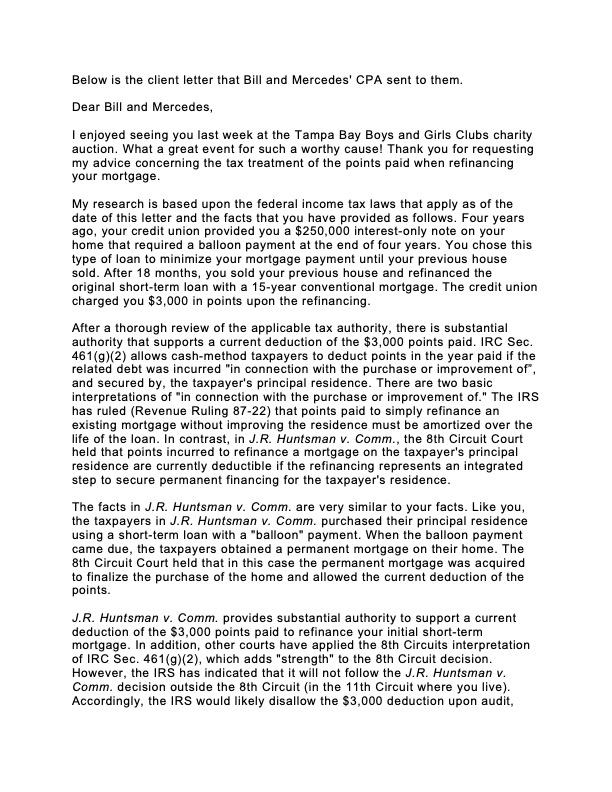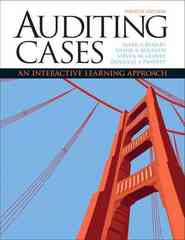Question
Tax Research Assignment The five steps in tax research are:... Tax Research Assignment The five steps in tax research are:
Tax Research Assignment The five steps in tax research are:...
Tax Research Assignment
The five steps in tax research are:
· understand the facts
· identify issues
· locate relevant authorities
· analyze the tax authorities
· communicate research results.
The two types of tax services that tax professionals use in tax research are annotated tax services, arranged by code section, and topical services, arranged by topic.
Research questions often consist of questions of fact or questions of law.
· The answer to a question of fact hinges upon the facts and circumstances of the taxpayer's transaction.
· The answer to a question of law hinges upon the interpretation of the law, such as interpreting a particular phrase in a code section.
When the researcher identifies that different authorities have conflicting views, she should evaluate the "hierarchy," jurisdiction, and age of the authorities.
Once the tax researcher has identified relevant authorities, she must make sure that the authorities are still valid and up to date.
The most common end product of a research question is a research memo, which has five basic parts: (1) facts, (2) issues, (3) authority list, (4) conclusion, and (5) analysis.
Sample Research Memo
Facts: Discuss facts relevant to the question presented—that is, facts that provide necessary background of the transaction (generally, who, what, when, where, and how much) and those facts that may influence the research answer. Keeping the fact discussion relatively brief will focus the reader's attention on the relevant characteristics of the transaction.
Issues: State the specific issues that the memo addresses. This section confirms that you understand the research question, reminds the reader of the question being analyzed, and allows future researchers to determine whether the analysis in the memo is relevant. Issues should be written as specifically as possible and be limited to one or two sentences per issue.
Authorities: In this section, the researcher cites the relevant tax authorities that apply to the issue, such as the IRC, court cases, and revenue rulings. How many authorities should you cite? Enough to provide a clear understanding of the issue and interpretation of the law. Remember, in order to reach an accurate assessment of the strength of your conclusion, you should consider authorities that may support your desired conclusion, as well as those that may go against it.
Conclusion: There should be one conclusion per issue. Each conclusion should answer the question as briefly as possible, and preferably indicate why the answer is what it is.
Analysis: The goal of the analysis is for the researcher to provide the reader a clear understanding of the area of law and specific authorities that apply. Typically, an analysis will be organized to discuss the general area(s) of law first (the code section) and then the specific authorities (court cases, revenue rulings) that apply to the research question. How many authorities should you discuss? As many as necessary to provide the reader an understanding of the issue and relevant authorities. After you discuss the relevant authorities, apply the authorities to your client's transaction and explain how the authorities result in your conclusion.
____________________________________________________________________________
Client Letters In addition to internal research memos, tax professionals often send their clients letters that summarize their research and recommendations. Basic components of the client letter include: (1) research question and limitations, (2) facts, (3) analysis, and (4) closing.
A sample letter is attached.
Tax Research Assignment 2.
Scenario:
Your client, I. M. Wheeler, is considering exchanging commercial property with R.E. Investments, Inc.
Wheeler owns a warehouse which she has held for investment since 2015 with a fair market value of $675,000, subject to a mortgage of $350,000 and an adjusted basis of $175,000.
R.E. Investments owns a rental property with a fair market value of $540,000, subject to a mortgage of $365,000.
The planned transaction is for Wheeler to exchange her property for R.E. Investments' property plus $150,000 cash. Each party will assume the mortgage on the property received.
Wheeler wants to make sure that the transaction qualifies for IRC Section 1031 like-kind exchange and has asked you to provide a memo detailing the requirements that must be satisfied for like-kind exchange treatment. Your memo should also analyze any gain realized and/or recognized, the taxation, if any, and Wheeler's basis in the new property.
Assignment:
You are to research the applicable law, using Nexis Uni [See Video "Accessing Nexis Uni 2022 - Short Video" in Course Resources>Learning Resources] and other online tax resources, such as, www.irs.gov. Identify the relevant statutory, regulatory, and other judicial authorities as discussed in those resources.
Then, using the format for communicating research findings discussed in your Tax Research Content materials, submit a brief memorandum addressed to I.M. Wheeler setting forth your conclusions which must include (a) the quantitative calculation of gain, if any, AND (b) Wheeler's basis in the property received in the exchange.
You will be graded on preparing a proper Memorandum, clearly communicating your answers, proper use of terms, properly citation and the correctness of your answers.

Below is the client letter that Bill and Mercedes' CPA sent to them. Dear Bill and Mercedes, I enjoyed seeing you last week at the Tampa Bay Boys and Girls Clubs charity auction. What a great event for such a worthy cause! Thank you for requesting my advice concerning the tax treatment of the points paid when refinancing your mortgage. My research is based upon the federal income tax laws that apply as of the date of this letter and the facts that you have provided as follows. Four years ago, your credit union provided you a $250,000 interest-only note on your home that required a balloon payment at the end of four years. You chose this type of loan to minimize your mortgage payment until your previous house sold. After 18 months, you sold your previous house and refinanced the original short-term loan with a 15-year conventional mortgage. The credit union charged you $3,000 in points upon the refinancing. After a thorough review of the applicable tax authority, there is substantial authority that supports a current deduction of the $3,000 points paid. IRC Sec. 461(g)(2) allows cash-method taxpayers to deduct points in the year paid if the related debt was incurred "in connection with the purchase or improvement of", and secured by, the taxpayer's principal residence. There are two basic interpretations of "in connection with the purchase or improvement of." The IRS has ruled (Revenue Ruling 87-22) that points paid to simply refinance an existing mortgage without improving the residence must be amortized over the life of the loan. In contrast, in J.R. Huntsman v. Comm., the 8th Circuit Court held that points incurred to refinance a mortgage on the taxpayer's principal residence are currently deductible if the refinancing represents an integrated step to secure permanent financing for the taxpayer's residence. The facts in J.R. Huntsman v. Comm. are very similar to your facts. Like you, the taxpayers in J.R. Huntsman v. Comm. purchased their principal residence using a short-term loan with a "balloon" payment. When the balloon payment came due, the taxpayers obtained a permanent mortgage on their home. The 8th Circuit Court held that in this case the permanent mortgage was acquired to finalize the purchase of the home and allowed the current deduction of the points. J.R. Huntsman v. Comm. provides substantial authority to support a current deduction of the $3,000 points paid to refinance your initial short-term mortgage. In addition, other courts have applied the 8th Circuits interpretation of IRC Sec. 461(g)(2), which adds "strength" to the 8th Circuit decision. However, the IRS has indicated that it will not follow the J.R. Huntsman v. Comm. decision outside the 8th Circuit (in the 11th Circuit where you live). Accordingly, the IRS would likely disallow the $3,000 deduction upon audit,
Step by Step Solution
There are 3 Steps involved in it
Step: 1
Update To IM Wheeler From Your Name Date Date Subject Examination of LikeKind Trade Exchange Realities I M Wheeler possesses a distribution center wit...
Get Instant Access to Expert-Tailored Solutions
See step-by-step solutions with expert insights and AI powered tools for academic success
Step: 2

Step: 3

Ace Your Homework with AI
Get the answers you need in no time with our AI-driven, step-by-step assistance
Get Started


